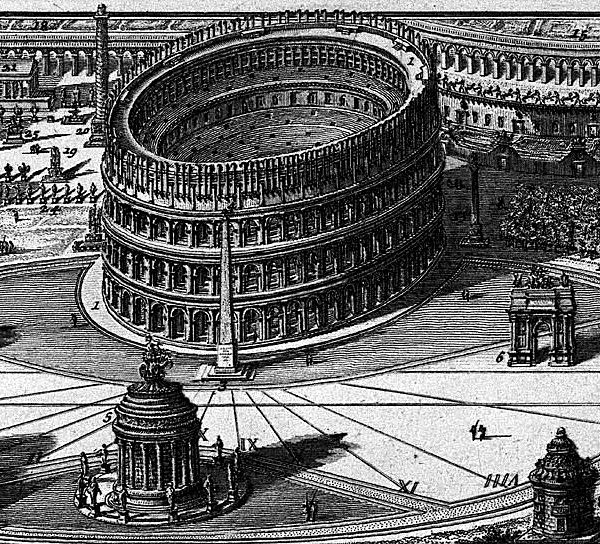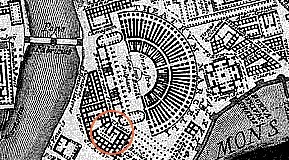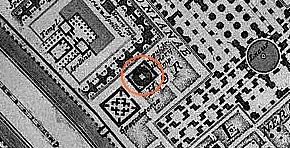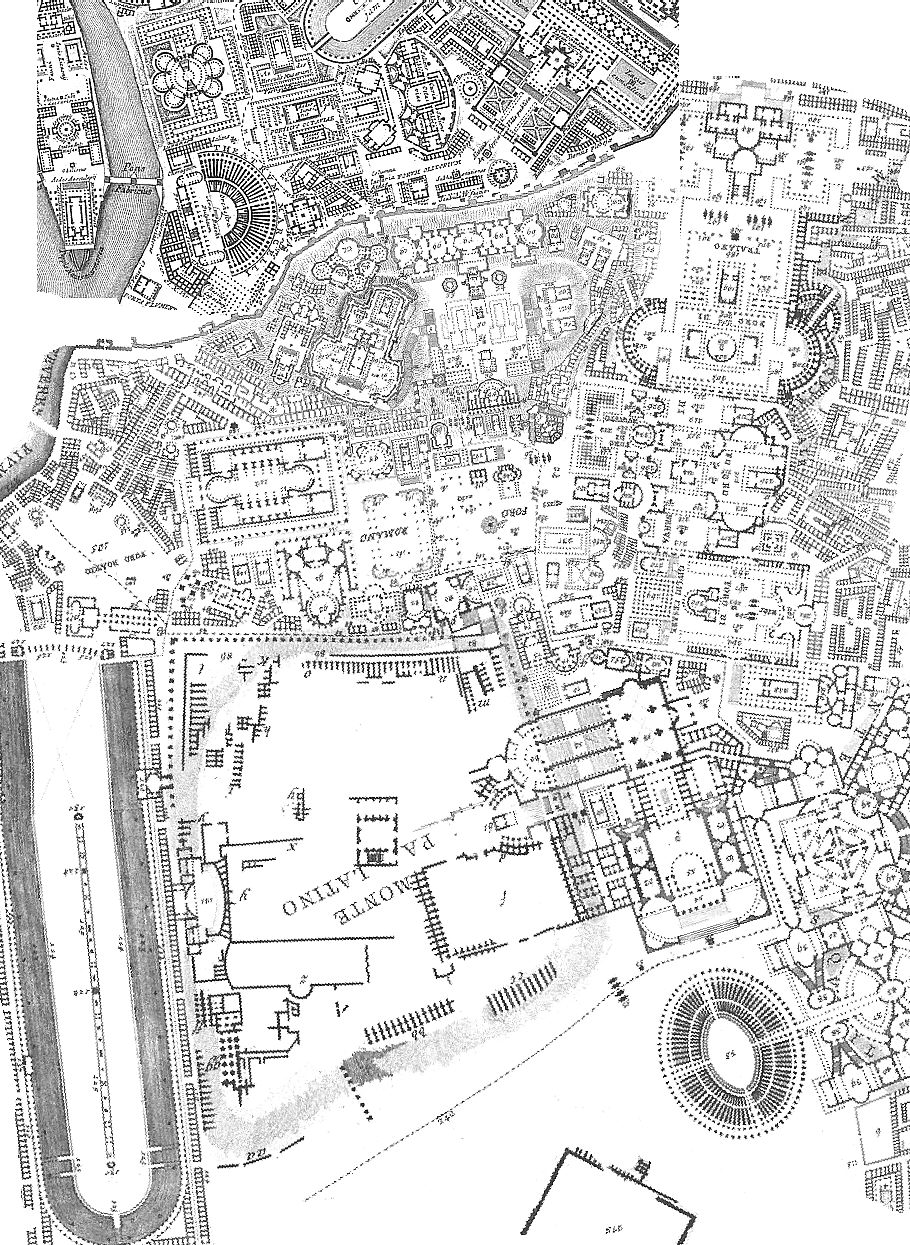Vincenzo Fasolo, "The Campo Marzio of G. B. Piranesi".
2691c
1956
1996.09.02
Tafuri text
1998.07.12
Ichnographia Campus Martius
The original plan with the dedication to Robert Adam is a huge plate in six sections which unfolds to about four feet eight inches by four feet ten. It is similar to the early baroque fantasies of the Forum and the Capitol at the end of the first volumn of the Antichità and bear as little resemblance to the actual layout of the old city. It is easy to see why the preface is so defensively worded in order to forestall the criticism which had probably been leveled against his over-enthusiastic imagination in the earlier maps. There is a medallion in one corner showing the joint heads of Adam and Piranesi.
Jonathan Scott, Piranesi (London: Academy Editions, 1975), p. 168.
2000.12.26
a change of plan
2001.01.15
Really Good Architecture
...this morning the postman delivered a Piranesi print, a print which I successfully bid on last weekend at eBay. It was the architecture of eBay that brought me Piranesi's engraving of ancient Rome's last Imperial artifact. I was confident in bidding on the print online via a written description and two digital images because of the Piranesi research that I have done and continue to do at home, online, and at university libraries. [By the way, Piranesi is a great proto-virtual-place architect.] This print of the sarcophagus of Maria, wife of the Emperor Honorius, was originally published within Piranesi's Il Campo Marzio (1762), specifically at the head of the dedicatory letter to Robert Adam. In true inversionary fashion, Piranesi cleverly placed an image of ancient Rome's last Imperial artifact at the beginning of the Il Campo Marzio publication.
| |
2001.03.05
sarcophagus of Maria
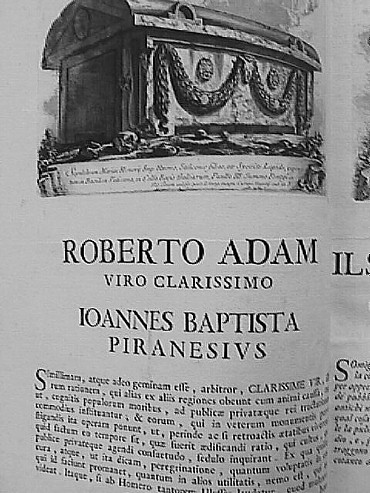
Beginning page of the
'Dedication' of Il Campo Marzio dell'Antica Roma in Latin.
|
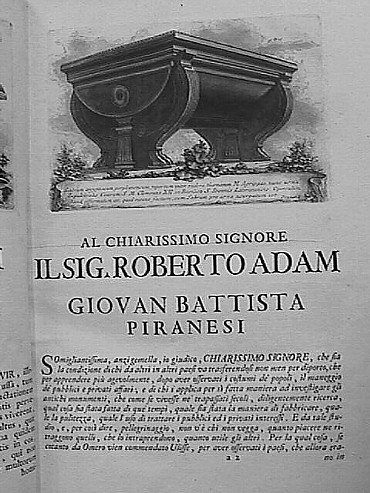
Beginning page of the
'Dedication' of Il Campo Marzio dell'Antica Roma in Italian.
|
A rendering of the sarcophagus of Maria appears within the Il Campo Marzio dell'Antica Roma publication as head-piece to the Latin dedication the publication to Robert Adam. This position makes the sarcophagus of Maria the third image within Il Campo Marzio after the title page and the frontispiece. Did Piranesi deliberately place ancient Rome's last imperial artifact at the very beginning of his documentation? Moreover, is it significant that the sarcophagus of Maria is the only ancient remain depicted within Il Campo Marzio that is Christian as opposed to Pagan?
Interestingly, a "sarcophagus of Egyptian porphyry found among the ruins of the baths of Agrippa, now the funerary urn for the ashes of Pope Clement XII [1730-40] in the Basilica of St. John Lateran" acts as head-piece to Il Campo Marzio's Italian dedication to Robert Adam.
Signs of ancient Rome's Pagan-Christian inversion.
| |
2005.08.05 13:00
Brideshead Revisited
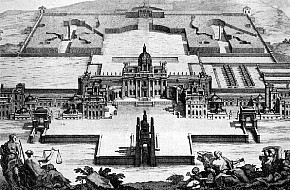
I'm now wondering whether the above image of Castle Howard from Vitruvius Britannicus (published 1715-1725) somehow inspired the architecture of Piranesi as delineated within Il Campo Marzio (1762). Remember the Ichnographia of the Campo Marzio (1757-62) is dedicated to Robert Adam. Did Adam show Piranesi Vitruvius Britannicus while he (Adam) was friends with Piranesi in Rome in the 1750s? In any case, the perspectival vantage point and indeed the architecture depicted within the perspectives of the Campo Marzio very much evoke the Castle Howard aerial perspective, for example the Frontispiece of the Campo Marzio:
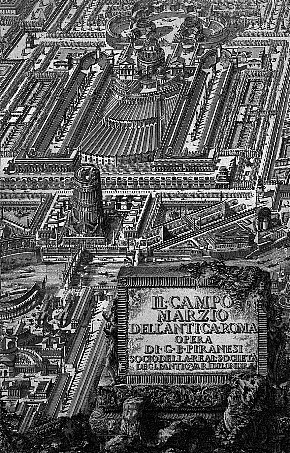
| |
2008.08.06 15:09
"How Did This Happen Revisited"
"...and in 1755 Robert Adam had Kent's Inigo Jones, Campbell's Vitruvius Britannicus and Lord Burlington's Baths, all sent to him in Rome." (London, Guildhall MS 3070 f. 11).
2008.08.10 11:29
Adam (sans Eve) in the Garden of Satire
Piranesi's close familiarity with [Hadrian's] Villa dates back at least to the 1750s, when there are accounts of sketching expeditions made in the company of Robert Adam, Clérisseau and Allan Ramsay.*
--John Wilton-Ely, The Mind and Art of Giovanni Battista Piranesi (London: Thames and Hudson, 1978), p. 41
*See John Fleming, Robert Adam and his Circle in Edinburgh and Rome, London and New York, 1962, passim.
passim : here and there: used in bibliographic references to indicate that the writer has drawn upon material scattered throughout the source cited.
In fact, there is no direct evidence within Robert Adam and his Circle in Edinburgh and Rome that Piranesi and Adams were ever together at Hadrian's Villa, nor does Adam every mention Piranesi having been to Hadrian's Villa. Was perhaps Adam at Hadrian's Villa before Piranesi ever was? It is on record that Adam was at the Villa d'Este mid-June 1755. And again Adam led a survey and drawing expedition at Hadrian's Villa for six days in April 1756.
Many of the specifics we have today regarding Piranesi's life from June 1755 to late-April 1757 come from the coeval letters of Robert Adam. According to Wilton-Ely: The new decade of the 1760s saw a broadinging of Piranesi's antiquarian concerns... A particular field of operation in this decade was Tivoli and the ruins of the nearby Hadrian's Villa.
Here and there indeed.
|




